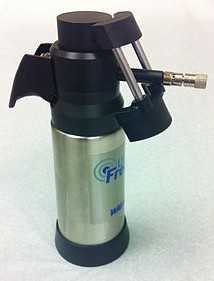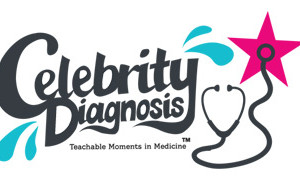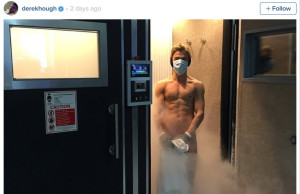DWTS Cast is Naked and Cold

Derek Hough and Maksim Chemerkovskiy were afraid that their manly parts might freeze and fall off. But afterwards, Maks said
I would do it every day for the rest of my life.
Katherine Jenkins hit a high note after she stripped down and exposed herself to ultra low temperatures.
Maria Menounos found a “cool” new way to treat her dance injuries that include 2 broken ribs and stress fracture in her feet.
Take a look:
Getting Naked at 200 Degrees Below Zero - Why?
Cryotherapy is defined as the local or general use of low temperatures in medical therapy or the removal of heat from a body part. It has been around since the 1880-1890s.
Its goal is to decrease cellular metabolism, increase cellular survival, decrease inflammation, decrease pain and spasm, promote constriction of the blood vessels, and when using extreme temperatures, to kill cells by freezing them.
The most prominent use of the term refers to the surgical treatment, specifically known as cryosurgery. Other therapies that use the term are cryogenic chamber therapy (or whole body cryotherapy - WBC) and ice pack therapy.
Cryosurgery
 Cryosurgery is the application of extreme cold to destroy abnormal or diseased tissue. It is used to treat a number of diseases and disorders, most especially skin conditions like warts, moles, skin tags and solar keratoses. Liquid nitrogen is usually used to freeze the tissues at the cellular level. The procedure is used often because it is highly effective with a low rate of side effects.
Cryosurgery is the application of extreme cold to destroy abnormal or diseased tissue. It is used to treat a number of diseases and disorders, most especially skin conditions like warts, moles, skin tags and solar keratoses. Liquid nitrogen is usually used to freeze the tissues at the cellular level. The procedure is used often because it is highly effective with a low rate of side effects.
Ice Pack Therapy
 Ice Pack Therapy is is commonly used to alleviate the pain of minor injuries. A cold pack is applied to a specific area to absorb heat by thermal transfer. The physiologic effects of cold application include an immediate blood vessel constriction followed by a reflex increase in blood flow, a decrease in local metabolism and a decrease in oxygen demand.
Ice Pack Therapy is is commonly used to alleviate the pain of minor injuries. A cold pack is applied to a specific area to absorb heat by thermal transfer. The physiologic effects of cold application include an immediate blood vessel constriction followed by a reflex increase in blood flow, a decrease in local metabolism and a decrease in oxygen demand.
Applying an ice pack early and frequently during the first 48 hours after an injury will help minimize swelling. This also helps to control the pain.
Ice pack therapy can also be used in chronic injuries, such as for overuse injuries in athletes. Icing the injured area after activity can help control inflammation.
Enter the Ice Sauna but Don’t Stay Too Long
Whole Body Cryotherapy
Whole body cryotherapy originated in Japan in 1978. A patient is placed in a special temperature-controlled cryogenic chamber (sometimes called a “space ship”) for a short period of time- usually on the order of 2 to 3 minutes. The temperature in the chamber is held at about minus 270 degrees Fahrenheit! To prevent frostbite, patients dress in protective clothing composed of cotton socks, cotton underwear (for men), and gloves.
In theory, this is how it works-
- The extreme cold rapidly drops the temperature of the skin.
- The body’s temperature regulating system wants to protect the body’s core temperature. It does it by constricting the blood vessels in the extremities. This shifts blood away from the arms and legs and towards the heart, lungs and brain.
- This body becomes oxygen rich.
- When the body is removed from the cold temperatures, the oxygen rich blood floods into the skin and extremities as the body dilates the blood vessels.
Menounos’s doctor, Dr. Jonas Kuehne (who happens to own CryoHealthcare) claims that, in addition to increased oxygen delivery, “extreme temperatures also triggers the release of anti-inflammatory molecules and endorphins”.
Does it really work? Can it hurt me?
Many professional athletes, such as Texas Rangers’ pitcher C.J. Wilson, as well as several members of the NBA Champion Dallas Mavericks team, swear by the procedure but that doesn’t mean it’s been scientifically proven to work. The doctor who has published the most articles in medical journals about WBC is Giuseppe Banfi at the University of Milan in Italy. According to Dr. Banfi:
“WBC is used to relieve pain and inflammatory symptoms caused by numerous disorders, particularly those associated with rheumatic conditions, and is recommended for the treatment of arthritis, fibromyalgia and ankylosing spondylitis. In sports medicine, WBC has gained wider acceptance as a method to improve recovery from muscle injury. Unfortunately, there are few papers concerning the application of the treatment on athletes….further studies are necessary…”
Dr. Banfi goes on to say
WBC is not harmful and does not induce general or specific negative effects…
….Except perhaps on your bank account. Dr. Kuehne’s treatments cost $70 for 2-3 minutes in the cold and 5 to 20 treatments are usually prescribed. I’d be surprised if your health insurance covers this.



























0 comments